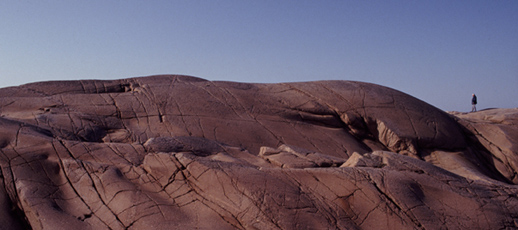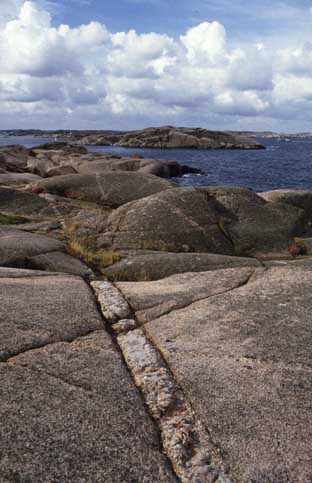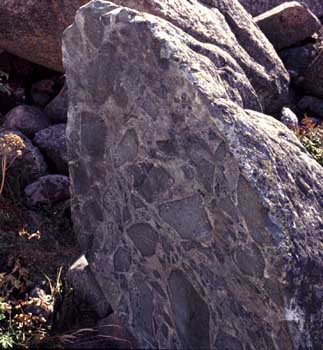|
The landscape of granite |
||
 |
||
|
Coarse-grained granite is the kind that is mostly in evidence when you are walking in the Stångehuvud area. Fine examples of coarse-grained granite are visible at the steps when walking on the path between Stångholmesund and Kramkistesund. In the eastern part of Stångehuvud there is another granite type. This is the more "normal", medium-grained version. In the hillside about 75 metres to the west of Gullmarsvallen there is a sharp delineation between the coarse-grained and the medium-grained granite types. Such a clear distinction between different types of granite is seldom seen in the province of Bohuslän. At Galleberget, in the north of Stångehuvud, the medium-grained granite type is predominant. Pegmatite veins crisscross Typical for the granite landscape in Stångehuvud is that it is crossed by paths of a different rock type, pegmatite. In some places, you can follow these paths for hundreds metres. Pegmatite can be said to be a granite with very large crystals. The rock was formed in the latter part of the period when the granite magma was solidified. Gradually tensions occured in the rock, resulting in cracks, usually one or a few decimetres wide. To these cracks were drawn water-rich solutions from the ambient, not yet hardened granite, which crystallized slower than the ordinary granite. The result was pegmatite which has the same mineral composition as granite, but with much larger crystals. Stonemasons used to call these pegmatite veins "cat" or "cat stripes". These veins were, for obvious reasons, not very popular among the stone workers, because it was not worthwile breaking granite in places with numerous pegmatite veins. A very special formation of pegmatite has given its name to the so called Lejonpallen, which is marked on the map of Stångehuvud from 1892. The inland ice has formed the landscape The pristine parts
of the mountain landscape of Stångehuvud got their present appearance during the last
deglaciation almost Like a giant plane, it slid forward and levelled the mountain. When the climate became warmer, numerous tunnels with meltwater were created under the ice in the area of contact with the granite. Under very high pressure and mixed with gravel, stone, blocks etc, the melt water was forced upward and polished the granite. |
Read more about the granite: How was the Bohus granite formed? What consists the Stångehuvud granite of and what gives it the red colour?
|
|

